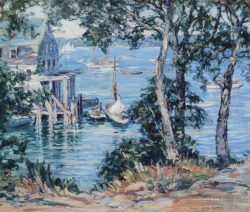Florence White Williams 1895–1953
Relatively little is known of Florence White Williams’s life. Born in Putney, Vermont, she studied at the Chicago Academy of Fine Arts and at the Art Institute of Chicago, where her teachers included Carl Krafft and Frederic M. Grant. In 1924 she won first prize in the Art Students’ League exhibition. Williams also studied with Henry B. Snell, likely at Boothbay Studios, the summer school he opened in 1921 in Boothbay Harbor, Maine.
In the Art Institute Alumni Association’s retrospective exhibition in 1922, Williams showed illustrations as well as paintings, and she would continue to work in both fields through the decade. She had already written and illustrated a volume of poems for children, the first of several such projects, and made illustrations for magazines and greeting cards. As an illustrator, Williams focused on children and animals, while landscape was the field in which she developed a modest reputation as a painter, in the 1920s.
Williams made her debut in the Art Institute’s annual exhibitions in the 1924 “Chicago and Vicinity” show; she was also represented in two of the museum’s watercolor annual exhibitions. Although she participated in group exhibitions in Baltimore, Detroit, Milwaukee, and Washington, DC, her professional reputation was largely confined to Chicago. She belonged to the Association of Chicago Painters and Sculptors, a conservative group, and showed repeatedly at the Chicago Galleries Association, a sympathetic venue for the city’s more conventional artists. There, in 1928, she had a solo exhibition of oil and watercolor paintings featuring her favorite setting, coastal New England, to which she made summer visits, as well as images of local scenery. Later in 1928, Williams made her only known excursion abroad, to Spain, Portugal, and the Azores, which inspired numerous paintings.
Williams lived in Chicago’s Kenwood neighborhood and was active in the South Side Art Association, particularly in its efforts to place works of art in public schools. She lectured locally and promoted herself as a writer and teacher as well as painter and illustrator. In 1932, Williams won a silver medal at the All-Illinois Society of the Fine Arts exhibition, and the following year she was represented in a display of art by Illinoisans organized to coincide with Chicago’s Century of Progress exposition. Williams’s last known exhibition was a group show at the Service Men’s Center in Chicago in 1941. Around 1945 she moved to Greenfield, Massachusetts. There she spent the rest of her life, but her further professional art activity is unrecorded.
Wendy Greenhouse, PhD
